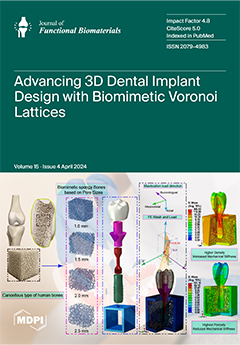This study aimed to develop gelatin methacryloyl (GelMA)-injectable hydrogels incorporated with 58S bioactive glass/BG-doped with strontium for vital pulp therapy applications. GelMA hydrogels containing 0% (control), 5%, 10%, and 20% BG (
w/
v) were prepared. Their morphological and chemical properties
[...] Read more.
This study aimed to develop gelatin methacryloyl (GelMA)-injectable hydrogels incorporated with 58S bioactive glass/BG-doped with strontium for vital pulp therapy applications. GelMA hydrogels containing 0% (control), 5%, 10%, and 20% BG (
w/
v) were prepared. Their morphological and chemical properties were evaluated by scanning electron microscopy/SEM, energy dispersive spectroscopy/EDS, and Fourier transform infrared spectroscopy/FTIR (n = 3). Their swelling capacity and degradation ratio were also measured (n = 4). Cell viability (n = 8), mineralized matrix formation, cell adhesion, and spreading (n = 6) on DPSCs were evaluated. Data were analyzed using ANOVA/post hoc tests (α = 5%). SEM and EDS characterization confirmed the incorporation of BG particles into the hydrogel matrix, showing GelMA’s (C, O) and BG’s (Si, Cl, Na, Sr) chemical elements. FTIR revealed the main chemical groups of GelMA and BG, as ~1000 cm
−1 corresponds to Si-O and ~1440 cm
−1 to C-H. All the formulations were degraded by day 12, with a lower degradation ratio observed for GelMA+BG20%. Increasing the concentration of BG resulted in a lower mass swelling ratio. Biologically, all the groups were compatible with cells (
p > 0.6196), and cell adhesion increased over time, irrespective of BG concentration, indicating great biocompatibility. GelMA+BG5% demonstrated a higher deposition of mineral nodules over 21 days (
p < 0.0001), evidencing the osteogenic potential of hydrogels. GelMA hydrogels incorporated with BG present great cytocompatibility, support cell adhesion, and have a clinically relevant degradation profile and suitable mineralization potential, supporting their therapeutic potential as promising biomaterials for pulp capping.
Full article






